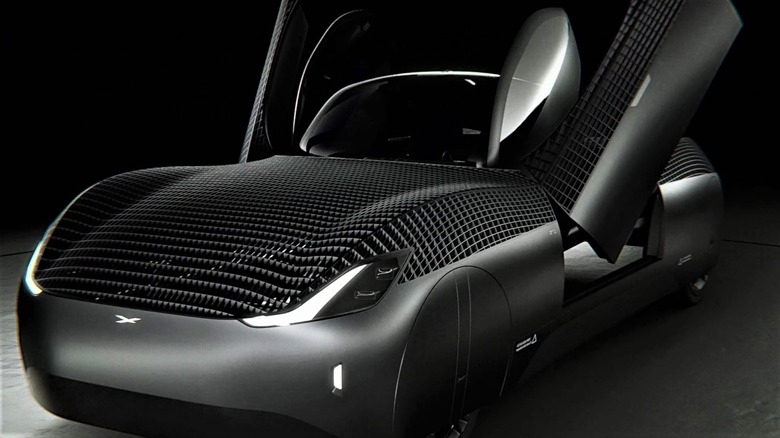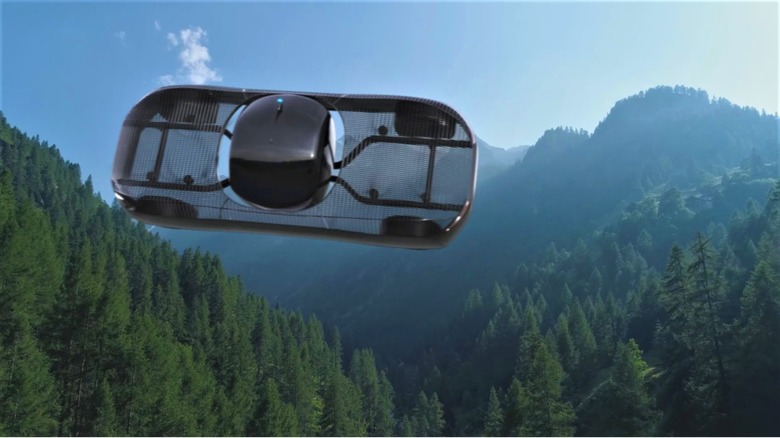This New Concept Could Be The First True Flying Car
A new EV concept is aiming to become the first flying car in the world capable of functioning on land as well as it does in the air, and it might be coming sooner than you think. Technological advancements are now pushing the notion of flying cars out of science fiction and straight into reality. It's come to a point where even renowned automakers like Volkswagen have their own take on a flying car. Some of these concepts are already showing progress, with vehicles like the AirCar even given the approval to fly in public airspace already. However, many of these so-called flying cars just look like aircraft that are capable of driving on land, usually consisting of integrated wings, propellers, and the like.
Another company hoped to address this by envisioning regular-looking cars that can actually fly, not the other way around. This is where Alef Aeronautics comes into the picture; a flying car technology company that developed what they deem is the world's first-ever flying car in the truest sense of the word. The Model A is Alef's first attempt at that, an unassuming all-electric vehicle that can be driven around like a normal car, except it can also take off, well ... on the fly. What separates this flying car invention from similar concepts is how it promises to seamlessly convert from a compact land vehicle to a full-blown aircraft courtesy of its Vertical Take-Off and Landing (VTOL) system. Of course, how it manages to do just that without any visible wings is just as impressive.
Is it a bird, a plane, or just a car that flies?
Like similar outlandish ideas, such as Jay Leno's wild jet car concept, the Model A started from a flying car drawing on a piece of napkin in 2015, per Alef. It took the company only four years to come up with a functional flying prototype, then another three years to unveil the Model A to the public. A YouTube video of its grand reveal shows a futuristic-looking vehicle with a unique mesh pattern exterior. This design was meant to allow air to flow through its chassis, which hides multiple propellers underneath. Powering the first-ever VTOL car hybrid are four small electric motors situated on each wheel. So, how does a wingless car fly, exactly?
After using its propellers to lift itself off the ground, the Model A's chassis flips backward, while its cockpit swivels forward like a gimbal. It utilizes the bulk of its body like integrated wings when propelling itself forward mid-air, turning the car into a fully-functional biplane. But when it's time to land, the Model A simply converts back into car form, then hovers back down like a helicopter. Having no discernible protruding wing parts allows this flying car to fit in places where other UAVs or similar winged vehicles struggle, foregoing the need for wide helipads or parking spaces. If all this sounds too far-fetched for real-life usage, Alef claims a prototype had already accomplished numerous successful test flights. Sure, this flying car concept seems to check all the boxes, but is it actually attainable?
How much will the world's first flying car cost?
The price of the first true flying car starts at $300,000, with the Model A specs offering a 200-mile driving range, a 110-mile flight range, and seating for up to two people. However, Alef's goal isn't just to come up with the first flying car in the world, but to mass produce one that's also suitable for the general public, not just one-percenters. For that, Alef is producing a cheaper alternative dubbed the Model Z. It features a more generous seating capacity of up to six people, along with an estimated 300-mile driving and 220-mile flight range, all for a fraction of what other flying cars typically cost.
The Model Z's $35,000 price tag is even cheaper than Tesla and Polestar's entry-level EVs, making it one of the first true flying cars that is quite affordable. What makes this project much closer to reality is its expected release window, with the Model A being planned for production as soon as 2025, followed by the Model Z in 2035. In fact, those with deep pockets can already pre-order the Model A on Alef's website. That's not to say there won't be obstacles along the way though, as such a feat would require going through various technical hurdles (via BBC). Hardware constraints, infrastructure limitations, and regulatory requirements are all standing in the way, and overcoming those will likely take much longer than developing the flying car invention itself.

